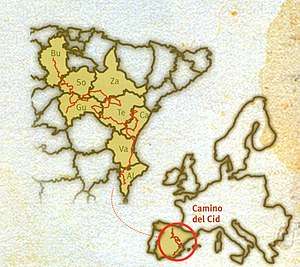Camino del Cid

The Camino del Cid is a cultural tourist itinerary based on historical personage Rodrigo Díaz and the literary work El Cantar de mio Cid. In both cases they are references of international scope: El Cid, "Castilian hero par excellence, the most exalted knight of medieval Spain" and El Cantar de Mio Cid, "one of the great classics of European literature".
The route crosses eight Spanish provinces (Burgos, Soria, Guadalajara, Zaragoza, Teruel, Castellón, Valencia and Alicante) belonging to four Autonomous Communities (Castile and Leon, Castilla-La Mancha, Aragon and Valencian Community). It can be traveled both by road and by footpath.
Origins of the Camino del Cid
In the Cantar de mio Cid, the author uses references mixing history and fiction. The route taken by the historic Cid does not correspond exactly with that described in the poem. The author would have used the historical references in his reach added to his own knowledge of geography to draw a route traced mainly by Roman roads, trade routes and historic paths. Based on this theory, it is not possible to speak of an imaginary road, but rather of a network of paths and places on which the Poem of Cid is based. This network of paths - some of which still exist today - began to be transited as itineraries of the Cid towards the end of the nineteenth century, when Archer Milton Huntington, founder of the Hispanic Society of America, followed shortly thereafter by the search for traces of the Cid through the Castilian and Aragonese lands by the philologist Ramón Menéndez Pidal and his wife Maria Goyri.
The poem
The Camino del Cid, based on the famous poem, is a literary journey. Several specific localities related to the historic El Cid are cited in this poem.
The lack of sources and the accuracy of the latter are the main reasons for the impossibility to trace a faithful historical path of places related to El Cid, explains the use of the poem as the main source of the route. If the sources are confirmed, then its long length would make impossible its configuration as a tourist route, because several other provinces would be added to the official provinces, such as Zamora, Murcia, Oviedo, Seville, Barcelona or the autonomous communities of La Rioja and Navarre .
Since its origins, the route is identified with the path taken by El Cid in the Cantar de mio Cid. In addition, the poem has helped to better understand the character, which is part, with Don Quixote and Don Juan, literary characters most famous Spanish literature.
Places of interest
The Camino del Cid has a diversity of resources. There are monuments of medieval origin that are listed as World Heritage Sites such as Burgos Cathedral, Mudéjar Architecture of Aragon, Valencia Silk Lodge or Elche Palm Grove, plus many heritage sites and towns. Important cultural centers on the trail include Covarrubias (Burgos), Burgo de Osma (Soria), Sigüenza (Guadalajara), Calatayud, Ateca and Daroca (Zaragoza), Albarracín (Teruel), Morella (Castellón), Xàtiva (Valencia) and Elche and Orihuela (Alicante).
There are also other sites of interest. There are examples of Romanesque, Mozarabic, Mudejar, Islamic and Gothic art coexisting in harmony as well as valuable landscapes such as the fields of de Genèvrier in Arlanza (Burgos), the Parque natural del Alto Tajo (Guadalajara), the Laguna de Gallocanta (Zaragoza), the Sierra de Maestrazgo (Teruel and Castellón), the lake and Natural Park of the Albufera de Valencia or the Palmeral of Elche (Alicante).
As a result of this, the provincial deputation of Burgos created in 1966 a hiking trail connecting Vivar del Cid to Saint Peter Cardeña through the city of Burgos, the three fundamental stages mentioned in the first verses of the poem.
Sources
- The information in this article is based on that in its Spanish equivalent.
- Camino del Cid website
- Lonvia